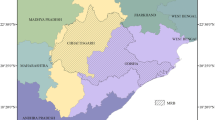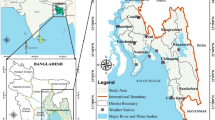Abstract
Land in India is changing in a rapid pace since the green revolution during 1960 and industrial policy reforms during 1990. Certainly land cover land use (LCLU) changes have huge impacts on countries overall ecological balance and climate change. The most intriguing fact is LCLU change is an interconnected phenomenon like a system. The understanding of local level LCLU dynamics are yet to get a momentum in India. The present study is an attempt: (1) to examine the land use change drivers active at the studied landscape of coastal Karnataka in India and (2) to model the LCLU changes in pre-industrialized period using Dyna-CLUE model. Binary logistic regression was used to categorize land change drivers and to estimate the probability of changes. Odd ratio from logistic regression indicates that the biophysical drivers are most prominent in determining location of LCLU. They being slope, relative relief, drainage density and availability of ground water are the most influential drivers for most of the land classes. The Dyna-CLUE model is successful to simulate the LCLU change at aggregate level but the spatial allocation needs improvement.









Similar content being viewed by others
References
Agarwal C, Green MG, Grove JM, Evans TM, Schweik CM (2002) A review and assessment of land-use change models: dynamics of space, time, and human choice. United States Department of Agriculture, Forest Service North eastern Research Station. General Technical Report NE-297
Behera MD, Borate SN, Panda SN, Behera PR, Roy PS (2012) Modelling and analyzing the watershed dynamics using cellular automata (CA)-Markov model—a geo-information based approach. J Earth Syst Sci 121(4):1011–1024
Brown C, Brown K, Rounsevell M (2016) A philosophical case for process-based modelling of land use change. Model Earth Syst Environ 2(2):1–12
Census of India (2011a) District Census Handbook-Udupi. Directorate of census operations Karnataka
Census of India (2011b) District Census Handbook-Dakshina Kannada. Directorate of census operations Karnataka
Chu HJ, Wu CF, Lin YP (2013) Incorporating spatial autocorrelation with neural networks in empirical land-use change models. Environ Plan B Plan Design 40(3):384–404
Concept Note (2012) Land use planning for optimum utilization of land resources. The Department of Land Resources, Ministry of Rural Development (MoRD), Government of India and Deutsche Gesellschaft für Internationale Zusammenarbeit (GIZ). 7 pp
e Silva FB, Koomen E, Diogo V, Lavalle C (2014) Estimating demand for industrial and commercial land use given economic forecasts. PloS One 9(3), e91991, 1–14
Gazetteer Department (2011) Dakshina Kannada District Gazetteer. Chief Editor S. Anees Siraj. http://gazetteer.kar.nic.in/gazetteer/distGazetteer.html#
Gazetteer Department (2012) Udupi District Gazetteer. Chief Editor S. Anees Siraj. http://gazetteer.kar.nic.in/gazetteer/distGazetteer.html#
Ghatak M, Ghosh P (2011) The land acquisition bill: a critique and a proposal. Econ Polit Wkly XLVI(41):65–72.
Joshi BK, Bisht SS, Pant R, Kothyari BP (2005) Sustainable land use management options for non-arable land resources in Indian central Himalaya. ENVIS Bull Himal Ecol 13(1)
Kindu M, Schneider T, Teketay D, Knoke T (2015) Drivers of land use/land cover changes in Munessa–Shashemene landscape of the south-central highlands of Ethiopia. Environ Monit Assess 187(7). doi:10.1007/s10661-015-4671-7
Koch J, Wimmer F, Onigkeit J, Schaldach R (2012) An integrated land-use system model for the Jordan River region. INTECH Open Access Publisher
Legates DR, McCabe GJ (1999) Evaluating the use of “goodness-of-fit” measures in hydrologic and hydroclimatic model validation. Water Resour Res 35(1):233–241
Li W, Wu C (2013) A spatially explicit method to examine the impact of urbanisation on natural ecosystem service values. J Spat Sci. doi:10.1080/14498596.2013.797372
Lin Y, Chu H, Wu C, Verburg PH (2011) Predictive ability of logistic regression, auto-logistic regression and neural network models in empirical land-use change modelling—a case study. Int J Geogr Inf Sci 25(1):65–87. doi:10.1080/13658811003752332
Liu XH, Andersson C (2004) Assessing the impact of temporal dynamics on land-use change modelling. Comput Environ Urban Syst 28:107–124
Luo G, Yin C, Chen X, Xu, W. Lu, L (2010) Combining system dynamic model and CLUE-S model to improve land use scenario analyses at regional scale: a case study of Sangong watershed in **njiang, China. Ecol Complex 7(2):198–207
Mas J-F, Kolb M, Paegelow M, Olmedo MTC, Houet T (2014) Inductive pattern-based land use/cover change models: a comparison of four software packages. Environ Model Softw 51:94–111. doi:10.1016/j.envsoft.2013.09.010
Mather M (2006) Land-use system. In: Geist H (ed) Our Earth’s changing land: an encyclopaedia of land-use and land-cover change, vol 2. Greenwood Press, Westport, pp 379–386
Matthews R, Gilbert N, Roach A, Polhill G, Gotts N (2007) Agent-based land-use models: a review of applications. Landsc Ecol 22(10):1447–1459. doi:10.1007/s10980-007-9135-1
Moriasi DN, Arnold JG, Van Liew MW, Bingner RL, Harmel RD, Veith TL (2007) Model evaluation guidelines for systematic quantification of accuracy in watershed simulations. Trans Asabe 50(3):885–900
N.A.S (2013) Advancing land change modelling: opportunities and research requirements. Committee on Needs and Research Requirements for Land Change Modelling Geographical Sciences, Committee Board on Earth Sciences and Resources Division on Earth and Life Studies, National research council of the National academics. The National Academies Press, Washington, D.C, p 135
Nagendra H, Sudhira HS, Katti M, Tengö M, Schewenius M (2014). Urbanization and its impacts on land use, biodiversity and ecosystems in India. Interdisciplina 2(2):305–313
O’Mara MP, Seto KC 2014. The influence of foreign direct investment on land use changes and regional planning in develo**-world megacities: a Bangalore case study. In: Kraas F, Aggarwal S, Coy M, Mertins G (eds) Megacities our global urban future. Springer, Berlin, pp 81–97
Overmars KP, Verburg PH (2005) Analysis of land use drivers at the watershed and household level: linking two paradigms at the Philippine forest fringe. Int J Geogr Inf Sci 19(2):125–152. doi:10.1080/13658810410001713380
Pandey B, Joshi PK (2015) Numerical modelling spatial patterns of urban growth in Chandigarh and surrounding region (India) using multi-agent systems. Model Earth Syst Environ 1(3):1–14
Prinz D, Rauch F (1987) The Bamenda model. Development of a sustainable land-use system in the highlands of West Cameroon. Agrofor Syst 5:463–474
Sohl TL, Claggett PR (2013) Clarity versus complexity: land-use modeling as a practical tool for decision-makers. J Environ Manag 129:235–243. doi:10.1016/j.jenvman.2013.07.027
Sudhira HS, Ramachandra TV, Wytzisk A, Jeganathan C (2005) Framework for integration of agent-based and cellular automata models for dynamic geospatial simulations. Technical Report: 100, Centre for Ecological Sciences. Indian Institute of Science, Bangalore, p 46
Tsarouchi GM, Mijic A, Moulds S, Buytaert W (2014) Historical and future land-cover changes in the Upper Ganges basin of India. Int J Remote Sens 35(9):3150–3176. doi:10.1080/01431161.2014.903352
Veldkamp A, Fresco LO (1996) CLUE: a conceptual model to study the conversion of land use and its effects. Ecol Model 85:253–270
Veldkamp A, Verburg PH, Kok K, de Koning GHJ, Priess J, Bergsma AR (2001) The need for scale sensitive approaches in spatially explicit land-use change modelling. Environ Model Assess 6:111–121
Verburg PH, Overmars KP (2009) Combining top-down and bottom-up dynamics in land-use modeling: exploring the future of abandoned farmlands in Europe with the Dyna-CLUE model. Landsc Ecol 24:1167–1181. doi:10.1007/s10980-009-9355-7
Verburg PH, Schot P, Dijst M, Veldkamp A (2004a) Land-use change modelling: current practice and research priorities. Geo J 64(4):309–324
Verburg PH, van Eck J.R.R., de Nijs T.C.M., Dijst MJ, Schot P (2004b) Determinants of land-use change patterns in the Netherlands. Environ Plan B Plan Design 31:125–150. doi:10.1068/b307
Verburg PH, Kok K, Pontius RG Jr, Veldkamp A (2006) Modeling land-use and land-cover change. In: Lambin EF, Geist H (eds) Land-use and land-cover change. Springer, Berlin, pp 117–135
Verburg PH, Eickhout B, van Meijl H (2008) A multi-scale, multi-model approach for analyzing the future dynamics of European land-use (Special Issue Paper). Ann Reg Sci 42:57–77. doi:10.1007/s00168-007-0136-4
Zhang P, Liu Y, Pan Y, Yu Z (2013) Land use pattern optimization based on CLUE-S and SWAT models for agricultural non-point source pollution control. Math Comput Model 58(3):588–595. doi:10.1016/j.mcm.2011.10.061
Zheng XQ, Zhao L, **ang WN, Li N, Lv LN, Yang X (2012) A coupled model for simulating spatio-temporal dynamics of land-use change: a case study in Changqing, **an, China. Landsc Urban Plan 106(1):51–61
Author information
Authors and Affiliations
Corresponding author
Rights and permissions
About this article
Cite this article
Ghosh, S., Shetty, A. Modelling the land use system process for a pre-industrial landscape in India. Model. Earth Syst. Environ. 3, 703–717 (2017). https://doi.org/10.1007/s40808-017-0329-5
Received:
Accepted:
Published:
Issue Date:
DOI: https://doi.org/10.1007/s40808-017-0329-5




